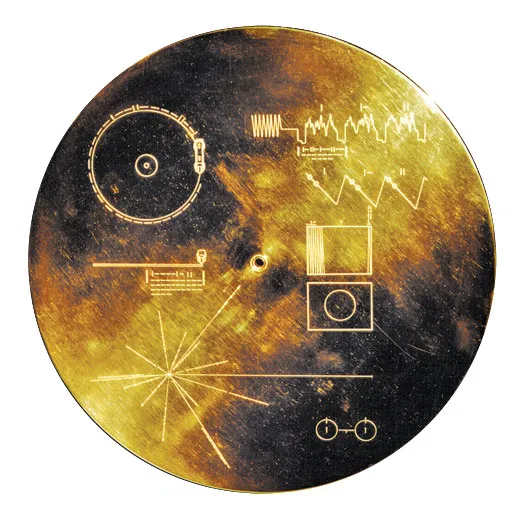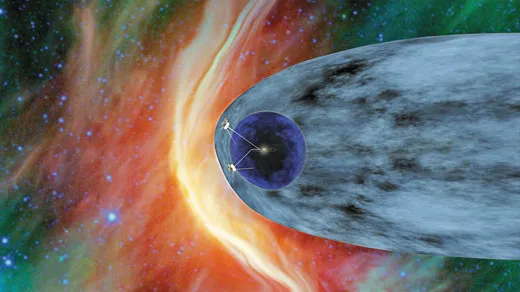Timothy Ferris on Voyagers’ Never-Ending Journey
With the spacecraft poised to leave our solar system, the writer who helped compile the time capsules they carry reflects on our foray into outer space
Exploration is one thing, science another—but they’ve come together rather nicely in the Voyager mission to the outer planets, outbound for the past 35 years yet still making discoveries.
The twin Voyager probes are currently poised on the brink of interstellar space. Both are immersed in the foamy walls of the transparent “heliospheric bubble,” where the solar wind, consisting of particles blown off the Sun, stalls against the stellar winds that permeate the rest of the galaxy. Astronomers don’t know how thick the bubble walls are—that’s for the Voyagers to ascertain—but they expect the probes to burst free and begin reporting from the great beyond within the next three years. This final phase of the probes’ scientific mission should last until around 2020 to 2025, when their plutonium power sources will falter and their radios fall silent.
Thereafter the Voyagers will wander forever among the stars, mute as ghost ships but with stories to tell. Each carries a time capsule, the “Golden Record,” containing information about where, when and by what sort of species they were dispatched. Whether they will ever be found, or by whom, is utterly unknown. In that sense, the probes’ exploratory mission is just beginning.
Having played an incidental role in the mission, as producer of the Golden Record, I attended the first launch, on August 20, 1977—Carl Sagan embracing me and shouting, “We did it!” over the rolling thunder of the Titan-Centaur rocket as it climbed into a blue Florida sky atop a roiling pillar of smoke—and was among the hundreds of journalists who showed up at the Jet Propulsion Laboratory (JPL) outside Los Angeles each time the probes swept by another planet. These “encounters,” as they were called, resembled school reunions, where those of us drawn together by passion or profession witnessed one another’s journeys from young upstarts to senior citizens.
Recently I caught up with a stalwart regular, Edward Stone, Voyager’s first and only mission scientist. Bright-eyed, mantis-thin and famously unflappable, Ed is now in his late 70s. He continues to work enthusiastically on Voyager plus three other NASA missions—including the upcoming Solar Probe Plus, designed to boldly fly a mere four million miles above the Sun’s blazing surface.
“One has to remember that when the Voyagers were launched,” Ed recalled, “the space age was only 20 years old. There was no way to know how long these things would work.” The space agency launched two probes, instead of just one, as an insurance policy against catastrophic failures at Jupiter and beyond.
Yet the Voyagers worked, not just for the 5 years demanded of its builders but for 35 years and counting.
They reached Jupiter in 1979, taking thousands of photos that revealed the complexity of the giant planet’s atmosphere and the surprising diversity of its satellites, from icy Europa to the lava lakes and spewing volcanoes of hellish Io. Slingshotting past Jupiter, they picked up enough speed (in exchange for an imperceptible reduction in Jupiter’s orbital inertia) to exceed the Sun’s escape velocity, inadvertently attaining starship status. The probes have been cruising ever since, as enthralled by gravitational fields as square-riggers are by winds.
Their newfound alacrity flung the Voyagers from Jupiter to Saturn in less than three years. They found that Saturn has not just the few rings observed from Earth but thousands of them, rippled and twisted into kinks by the gravitational interactions of Saturn’s many moons.
There the two spacecraft parted company. Voyager One took a close look at Saturn’s mysterious, cloud-enshrouded satellite Titan—of intense scientific interest because it has a dense atmosphere thought to resemble that of the infant Earth. The maneuver enabled scientists to nail down Titan’s diameter (3,200 miles) and to improve their understanding of its surface, where ethane lakes are thought to glisten under an atmosphere 60 percent denser than Earth’s. But it also flung Voyager One out of the plane of the solar system, ending its planetary mission.
Voyager Two, however, continued on to Uranus in 1986 and Neptune in 1989. All the close-up photos we have of Uranus—a weird world knocked on its side, presumably by colliding with another massive body when the solar system was young and unruly—and of ice-blue Neptune, whose satellite Triton displayed nitrogen geysers blasting through a frozen-nitrogen surface sheath, were taken by Voyager Two.
Scientists like to say that a discovery’s significance can be measured by how many prior scientific papers it renders obsolete. Whole shelves full of books about the Sun’s planets were rendered obsolete by the Voyager mission and by those that followed the trails it blazed—missions like Galileo, which orbited Jupiter 34 times before being deliberately incinerated in the Jovian atmosphere in 2003 (to ensure that it would never crash into and contaminate Jupiter’s satellite Europa, which may harbor an ocean of liquid water beneath its surface ice), and Cassini, which has been orbiting Saturn since 2004. It’s not that the pre-Voyager books were foolishly erroneous, but as human knowledge grows, our perspectives improve, altering our sense of what matters.
Sagan perceived, more clearly than most, Voyager’s potential to improve human perspectives. At his instigation, Voyager One looked back on Valentine’s Day 1990 and took photos of all the Sun’s planets as seen from high above the plane. The Earth took up just one pixel, Carl’s famous Pale Blue Dot. “That’s home,” he wrote. “Think of the rivers of blood spilled by all those generals and emperors so that, in glory and triumph, they could become the momentary masters of a fraction of a dot.”
Voyager One is now 11 billion miles out—so far that its radio signals, traveling at the velocity of light, take 16 hours to reach Earth. If you perched on Voyager One and looked back toward home, you’d see the Sun as just a bright star, south of Rigel, with Earth lost in its glare. Voyager Two, on its quite different trajectory, is 13 light-hours out. Radio signals from the two probes, captured daily by the Deep Space Network’s big dish antennas, arrive at a strength of less than one femtowatt, a millionth of a billionth of a watt.
Once the Voyagers reach interstellar space, they will encounter an environment so different from Earth’s environs as to challenge our homespun notions of what it means to go someplace. The Sun and all the other stars we see in the sky are orbiting the center of the Milky Way galaxy. Their orbital velocity—out here in the suburbs, some 27,000 light-years from the galaxy’s center—is 220 kilometers per second. That’s 500,000 miles per hour, more than ten times the Voyagers’ speed of 40,000 mph relative to the Sun. So when we speak of the Voyagers’ velocities we’re talking about small increments, like that of a car entering a freeway and edging across lanes of speeding traffic.
People ask when one of the Voyagers will encounter another star. The answer, according to JPL’s navigators, is that Voyager Two, 40,000 years from now, will pass within 1.7 light-years of the red dwarf star Ross 248. But what that really means is that Ross 248, sweeping by Voyager Two like a distant ocean liner viewed from a lifeboat, will be seen from the perspective of Voyager Two to slowly brighten over the millennia, then get dimmer for many more.
And that’s about it. The Voyagers will wheel around the galaxy, overtaking some stars and being overtaken by others but seldom getting close to any. Like you and me and everything else, the galaxy is mostly space: Fire a shotgun blast from one edge of its disk all the way through to the other, and the odds are not a single pellet will hit a star or planet. Hence the Voyagers are expected to remain adrift in space forever—that is, unless one of them eventually shows up on an alien starship’s radar screen and gets grappled aboard.
Which brings us back to the “Golden Record,” Voyager’s message for the ages. It’s a gold-plated copper disc, 12 inches in diameter, containing sounds of Earth, greetings in 55 languages spoken by 87 percent of the world’s population, 115 analog-encoded photographs and 90 minutes of music ranging from the bell-pure tones of Pygmy girls singing in a forest in Zaire to Beethoven’s Cavatina and Chuck Berry’s “Johnny B. Goode.” To facilitate playback, the aluminum case enclosing each record carries a ceramic phono cartridge plus a diagram showing how to use it. (The correct playback speed, 16 and 2/3 rpm, is diagrammatically defined in terms of the fundamental transition time of the hydrogen atom.) The record’s case also sports a pulsar map, showing Earth’s location at the epoch of launch, and a patch of uranium-238 from whose half-life the time elapsed since launch may be inferred.
The technology, though outdated, has the advantage of longevity. As Iron Age cuneiform inscriptions remind us, grooves cut into a stable medium can last a long time. The Voyager records should remain playable for at least a billion years before succumbing to erosion by micrometeorites and cosmic rays. A billion years is 5 times the age of the Atlantic Ocean, 5,000 times longer than Homo sapiens have existed.
It’s true, as Ed Stone says, that “Voyager is an incredible discovery machine, discovering things that we hadn’t even known we didn’t know.” But each probe is also a tough-as-nails, faster-than-a-speeding-bullet time capsule, carrying gifts proffered with no hope of return. Should extraterrestrials ever intercept it, that fact may speak volumes. It suggests that however primitive and ignorant we were, something in us was expansive enough to consider that we were not the universe’s only scientists, nor its only explorers.

